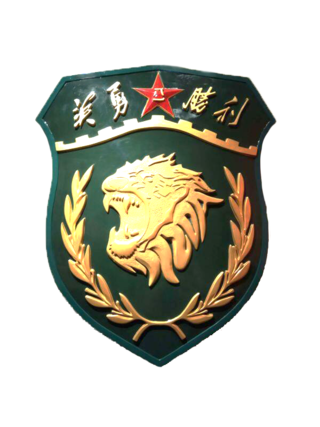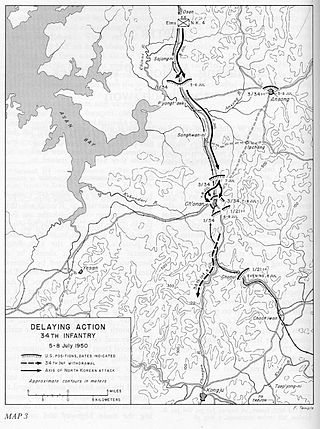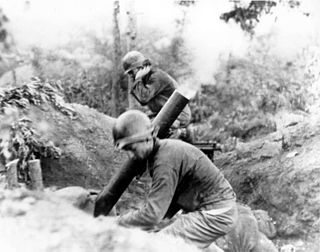
The 1st Provisional Marine Brigade was a marine brigade of the United States Marine Corps (USMC) that existed periodically from 1912 to 1950. It was an ad hoc unit formed for specific operations and not considered a "permanent" USMC unit.

The Battle of the Pusan Perimeter, known in Korean as the Battle of the Naktong River Defense Line, was a large-scale battle between United Nations Command (UN) and North Korean forces lasting from August 4 to September 18, 1950. It was one of the first major engagements of the Korean War. An army of 140,000 UN troops, having been pushed south to the brink of defeat, were rallied to make a final stand against the invading Korean People's Army (KPA), 98,000 men strong.

The 1st Infantry Division is a military formation of the Republic of Korea Army's I Corps. The division was established on 1947 under the command of Colonel Kim Suk-won.

The 6th Infantry Division is a military formation of the Republic of Korea Army.
The 12th Infantry Division was a division of the Korean People's Army during the 20th century. Originally, it was the 156th Division, which was created in November 1948 under the Regulation of the Redesignations of All Organizations and Units of the Army, issued by Central Military Commission on November 1, 1948, basing on the 6th Independent Division, PLA Northeastern Field Army.

The 79th Group Army, Unit 31671, formerly the 39th Group Army, is a military formation of the Chinese People's Liberation Army Ground Forces (PLAGF). The 79th Group Army is one of thirteen total group armies of the PLAGF, the largest echelon of ground forces in the People's Republic of China, and one of three assigned to the nation's Northern Theater Command.

The 112th Mechanized Infantry Division is a military formation of the People's Liberation Army of the People's Republic of China. The 112th Division was created in November 1948 under the Regulation of the Redesignations of All Organizations and Units of the Army, issued by Central Military Commission on November 1, 1948, basing on the 1st Division, 1st Column of the Northeastern Field Army. Its history can be traced to 5th Corps of the Chinese Workers' and Peasants' Red Army taking part in the Pingjiang uprising in 1928.

The 113th Mechanized Infantry Division, now the 113th Medium Combined Arms Brigade, is a military formation of the People's Liberation Army of the People's Republic of China.
The 150th Division, then 11th Garrison Division of Shenyang Military Region was a military formation of the People's Liberation Army of the People's Republic of China.
The 77th Armor is an armored (tank) regiment of the United States Army. The 77th Armor Regiment is part of the U.S. Army Regimental System with only a single battalion, the 1st Battalion, 77th Armor Regiment, and is therefore classified as both a single battalion and the remainder of the Regiment itself. 1–77 AR is currently stationed at Fort Bliss, Texas as part of the 3rd Brigade "Bulldogs", 1st Armored Division and has transformed from a tank pure battalion into a combined arms battalion (CAB).

The Battle of Taejon was an early battle of the Korean War, between U.S. and North Korean forces. Forces of the United States Army attempted to defend the headquarters of the 24th Infantry Division. The 24th Infantry Division was overwhelmed by numerically superior forces of the Korean People's Army (KPA) at the major city and transportation hub of Daejon. The 24th Infantry Division's regiments were already exhausted from the previous two weeks of delaying actions to stem the advance of the KPA.

The Battle of Pyongtaek was the second engagement between United States and North Korean forces during the Korean War, occurring on July 6, 1950 in the village of Pyongtaek in western South Korea. The fight ended in a North Korean victory following unsuccessful attempts by American forces to inflict significant damage or delays on advancing North Korean units, despite several opportunities to do so.

The Battle of Chonan was the third engagement between United States and North Korean forces during the Korean War. It occurred on the night of July 7/8, 1950, in the town of Chonan in western South Korea. The fight ended in a North Korean victory after intense fighting around the town, which occurred throughout the night and into the morning.

The Battle of Chochiwon was an early engagement between United States and North Korean forces during the Korean War, taking place in the villages of Jeonui-myeon and Jochiwon in western South Korea on July 10–12, 1950. After three days of intense fighting, the battle ended in a North Korean victory.

The First Battle of Naktong Bulge was an engagement between United Nations Command (UN) and North Korean forces early in the Korean War from August 5–19, 1950 in the vicinity of Yongsan and the Naktong River in South Korea. It was a part of the Battle of Pusan Perimeter, and was one of several large engagements fought simultaneously. The battle ended in a victory for the UN after large numbers of US reinforcements destroyed an attacking North Korean division.

The Battle of Taegu was an engagement between United Nations Command (UN) and North Korean forces early in the Korean War, with fighting continuing from August 5–20, 1950 around the city of Taegu, South Korea. It was a part of the Battle of Pusan Perimeter, and was one of several large engagements fought simultaneously. The battle ended in a victory for the UN after their forces were able to drive off an offensive by Korean People's Army (KPA) divisions attempting to cross the Naktong River and assault the city.

In the Battle of the Bowling Alley , United Nations Command (UN) forces defeated North Korean forces early in the Korean War near the city of Daegu, South Korea. The battle took place in a narrow valley, dubbed the "Bowling Alley", which was north of Daegu. It followed a week of fighting between the Korean People's Army (KPA) 13th Division and the Republic of Korea Army's (ROK) 1st Division along the latter's last defensible line in the hills north of the city. Reinforcements, including the US Army's 27th and 23rd Infantry Regiments were committed to bolster the ROK defenses. This battle and several others were smaller engagements of the Battle of Pusan Perimeter.
The Battle of Hwanggan was an engagement between United States and North Korean forces that took place on July 23–29, 1950, on a road north of the village of Hwanggan in southern South Korea, early in the Korean War. The battle ended in a victory for the North Koreans after US troops were forced to withdraw south.

The Second Battle of Naktong Bulge was an engagement between United Nations Command (UN) and North Korean forces early in the Korean War from September 1 to September 15, 1950, along the Naktong River in South Korea. It was a part of the Battle of Pusan Perimeter, and was one of several large engagements fought simultaneously. The battle ended in a victory for the United Nations after large numbers of United States Army (US) troops repelled a strong Korean People's Army (KPA) attack.

The Battle of Yongsan was an engagement between United Nations Command (UN) and North Korean forces early in the Korean War from September 1–5, 1950, at Yongsan in South Korea. It was part of the Battle of Pusan Perimeter and was one of several large engagements fought simultaneously. The battle ended in a victory for the UN after large numbers of United States Army (US) repelled a strong Korean People's Army (KPA) attack.















